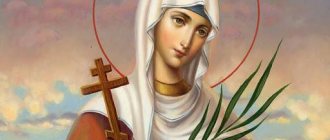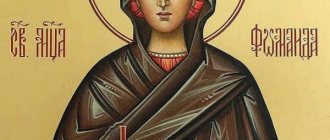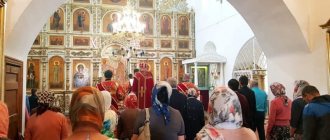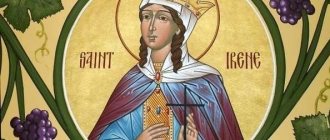Every year Orthodox people celebrate name days. According to the church calendar, the Day of Remembrance of the Holy Patroness Julia is celebrated several times a year.
In common people, name days are also called Angel Day, although there are differences between these days.
Name days are celebrated on the day of remembrance of the Patron Saint, and Angel Day is the day of receiving the Sacrament of Baptism. Orthodox believers attach special importance to these days, just like on their own birthday, they try to confess and take communion so that the holiday is not only physical, but also spiritual, from unity with the Lord.
Angel Julia Day
So, every person’s Angel Day can happen on any day. Everything will depend on when, in childhood, the child was brought to church to be baptized by his parents.
Believers try to adhere to the ancient tradition of baptizing a child on the 40th day after birth. But some people receive Holy Baptism as adults. So, people with the same names can have their name day on the same day, but Angel Day almost never.
Perhaps it’s useful for everyone to know when Elena’s name day is.
When is Julia’s name day according to the church calendar?
When choosing a name for a child, believing parents themselves choose his Patron Saint. As a rule, this happens even before the baby is born. Parents pray to the Saint, whose name their daughter or son will bear, so that the pregnancy is successful, the birth is successful, and then all their lives they ask the Saint for intercession, protection, and wisdom in raising a pious Christian.
If an adult does not know who his Patron Saint is, he can choose his own Intercessor. This is done simply. For example, an adult girl with the name Julia opens the Orthodox calendar and sees that the name “Julia” is not in the Saints, but there are Saints with the names Julia and Juliania.
The girl reads the lives of all the Saints she can find and chooses the one that is closest to her liking. And then her task will be not only prayer and requests for help in various matters to the chosen Saint, but also veneration - on the days of remembrance you need to attend church, confess and receive communion.
For believers, it is natural to turn daily to their Guardian Angel and Patron Saint in prayer.
What does it help with?
After the burial of Saint Julia, under a stone, at the site of her suffering, a source of pure healing water appeared. Many miracles occur in our time at the place where the Great Martyr Julia was crucified.
Especially often women who bear the same name turn to the icon of “Saint Julia”. The spiritual value lies in the incredible perseverance in faith shown by this girl. Even her pagan owner felt this strength; it was not for nothing that he considered her his amulet. And today the icon is able to give strength of spirit, protect and protect in difficult life situations.
To read: Soulless Strings. Why do I need a Church if God is in my soul?
The icon of Saint Julia helps and protects believers in difficult everyday situations. Helps to maintain faith when despair and disappointment creep into the soul. For women bearing this name, the image of Saint Julia is a helper and guide in life.
According to women, the icon of Julia of Carthage helps in many women’s affairs, therefore they often pray to this Saint for the health of children, for offspring, for the preservation of the family.
The Orthodox icon of Saint Julia to this day gives her grace to everyone who comes to her image with prayers. At the site of her crucifixion, Christians built a temple, to which Orthodox Christians come from many places to venerate the miraculous icon of St. Julia.
Nowadays, she is revered by both Orthodox and Catholics. Her feat became a source of inspiration for many artists. The local clergy claims that in Nontse, where she suffered death, in the church dedicated to her, her miraculous image is kept, and if you pray to it from the bottom of your heart, you will receive both blessing and help, and many pilgrims strive to the miraculous sources to receive healing.
Prayer to the icon
Oh, beloved of Christ, wonderful virgin Julie, you endured many sorrows from your childhood. Having been in slavery to the tongue, you remained faithful to Christ. She was not afraid of threats and did not succumb to seduction. Having maintained spiritual and physical purity, standing at the throne of the Lord, help us sinners who ask for your help to maintain purity and chastity. Having been tormented by evil tongues, you suffered until death. Deaths on the cross. Pray to the All-Merciful Savior to strengthen our faith and to send us patience in our sorrows! Having received grace from God to bestow healing on the sick, do not despise us sinners who ask for your help. Give us healing in our ills. Rejoice, great wonderworker, martyr Julia! Lamb of Christ pray to God for us! Amen.
Holy Martyr Julia of Carthage, Corsican
Memorial Day is July 29. Several centuries after the Nativity of Christ, the Great City of Carthage was once again treacherously captured and completely destroyed with pagan cruelty. Residents of the city were captured, among them was a small, innocent girl, Julia, ten years old.
In the general mass of people, forced by the pagans, walking far from their places of residence, Julia could not find her parents, friends, neighbors, tears literally consumed her childish face, when suddenly she heard the voice of God: “Blessed are those who mourn, for they will be comforted,” and she calmed down . The girl herself and other captives were taken to Syria, where everyone was sold into slavery. Julia tried not to think about home, prayed a lot and did her work carefully.
Her owner was imbued with bright feelings for her (as far as possible under the slave system) and did not even insist on renouncing Christ. And then one day the slave owner, taking Julia with him, went to travel to distant countries. Sailing past Julia's homeland, the ship, by the will of God, turned to the shores of Corsica, where the feast of the pagan invaders had already begun.
During the festival, the pagans learned that there was a maiden on the ship who was blaspheming their gods, and asked to sell her to them, but the owner refused. Then they, promising Julia freedom from slavery, ordered her to make a sacrifice to their gods. She refused. Immediately a hail of blows fell on Julia; she endured it, just as God endured her.
Having beaten Julia, the pagans crucified her on a wooden cross, as people once did to Christ, but until her last breath the girl was faithful to her faith. After the girl died, a small white bird (soul) flew out of her mouth. Seeing this, the pagans fled in fear and horror.
Soon the monks from Gorgon removed the girl’s body from the cross, and there were legends and legends about her will, loyalty and devotion to Christ. This is the life story of Saint Julia of Carthage, Corsican.
Meaning of the icon
It is worth noting that the icon of St. Julia of Carthage is equally revered in both Orthodoxy and Catholicism. The spiritual feat of this girl inspired various artists to create a miraculous image of her.
Thus, in the city of Nontsa, the place where Saint Julia was killed as a result of torture, there is a small church dedicated to her, in which there is an icon of the saint. This image of her, according to the stories of pilgrims, granted healing to many, which is why many strive to get to this place, unfamiliar to most.
To read The Church and the Mafia. Who built the temple in the village of Kushchevskaya?
The icon of Saint Julia of Carthage is an example of the steadfastness of faith, a symbol of infallible fidelity to God and resignation in accepting torment, readiness to endure any suffering and not to renounce Christ.
Important! The significance of this icon is especially great for people who have dedicated their lives to God today. The image of Saint Julia helps them cope with the hardships of monastic life and strengthens them in the faith.
Description of the Holy Face
It should immediately be noted that the main images of Saint Julia of Carthage are divided into two types:
- Icon of the Corsican iconographic school.
- Icons of the Orthodox school of icon painting.
In the city of Nontsa, in the church located at the site of the execution of the Holy Great Martyr Julia, an iconographic image is kept, which depicts Saint Julia of Carthage in accordance with the historical accuracy with which her execution is described. This is how she is represented, as well as Jesus Christ, on a crucifixion, with her breasts cut off during torture. This icon painting has been known since the 16th century and has several copies.
However, in Russia such an iconographic image was not accepted due to special chastity in accordance with Orthodox canons, which prohibit the depiction of a naked body on icons, even if this is evidence of the torture to which Saint Julia was subjected.
For this reason, the Russian Orthodox Church knows a different image of Saint Julia of Carthage - in it she holds the Holy Scriptures in her hands, and in later copies of the icon - a crucifix. In addition, there are several more versions of the icon of St. Julia, on them she is depicted next to such Saints as Nadezhda of Rome, St. Vladislav - the Serbian prince and the Monk David of Thessalonica.
Holy Martyr Julia of Ancyra (Corinth)
Memorial Day May 31st. The biography of the holy martyr Julia of Ancyra originates in the city of Ancyra (now the territory of Turkey) at the turn of the second and third centuries.
A tough pagan ruler, Theotekn, was appointed to Ancyra, whose main command was that Christians accept pagan sacrifices; in case of refusal, pagan heralds plundered the homes of Christians and destroyed the latter.
However, despite this, Julia of Ancyra, who professes faith in Jesus Christ, did not accept someone else’s faith and did not worship idols. For this refusal, Julia was drowned in the lake along with six saints who accepted martyrdom for Christian ideals.
At the moment, in Orthodox circles it is believed that the icon of Julia of Ankyra and a prayerful appeal to the martyr herself will protect from physical violence. There is also a temple of Julia of Ankyra in the Moscow region.
Prayer
Oh, beloved of Christ, wonderful virgin Julia, you endured many sorrows from a small age. Having been in slavery to the tongue, you remained faithful to Christ.
She was not afraid of threats and did not succumb to seduction. Having maintained spiritual and physical purity, standing at the throne of the Lord, help us sinners who ask for your help to maintain purity and chastity. Having been tormented by evil tongues, you suffered until death. Deaths on the cross.
Pray to the All-Merciful Savior to strengthen our faith and to send us patience in our sorrows! Having received grace from God to bestow healing on the sick, do not despise us sinners who ask for your help. Give us healing in our ills.
Rejoice, great wonderworker, martyr Julia! Lamb of Christ, pray to God for us! Amen.









